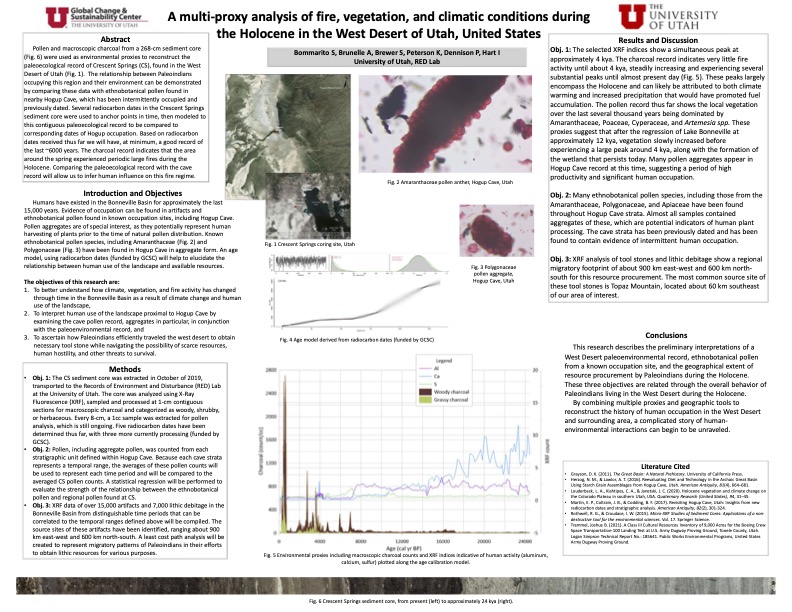A multi-proxy analysis of fire, vegetation, and climatic conditions throughout the Holocene in the West Desert of Utah, United States
–Savannah Bommarito, Andrea Brunelle, Isaac Hart
[bs_collapse id=”collapse_bb86-afd7″]
[bs_citem title=”Bio” id=”citem_e610-6c22″ parent=”collapse_bb86-afd7″]
I am a PhD student working with Andrea Brunelle. I am interested in the paleoenvironmental record of the West Desert of Utah, which I reconstruct using proxies such as pollen, charcoal, and X-Ray Fluorescence analysis. My past degrees are in Environmental Geology and Natural Resource Management from Central Washington University.
[/bs_citem]
[bs_citem title=”Abstract” id=”citem_eca8-96a7″ parent=”collapse_bb86-afd7″]
Pollen and macroscopic charcoal from a 268-cm sediment core were used as environmental proxies to reconstruct the paleoecological record of Crescent Springs, found in the West Desert of Utah. The relationship between Paleoindians occupying this region and their environment can be demonstrated by comparing these data with ethnobotanical pollen found in nearby Hogup Cave, which has been intermittently occupied and previously dated. Several radiocarbon dates in the Crescent Springs sediment core were used to anchor points in time, then modeled to this contiguous paleoecological record to be compared to corresponding dates of Hogup occupation. Based on radiocarbon dates received thus far we will have, at minimum, a good record of the last ~6000 years. The charcoal record indicates that the area around the spring experienced periodic large fires during the Holocene. Comparing the paleoecological record with the cave record will allow us to infer human influence on this fire regime.
[/bs_citem]
[bs_citem title=”Narrative” id=”citem_780c-0f71″ parent=”collapse_bb86-afd7″]
Pollen and charcoal from a 268-cm sediment core were used as environmental proxies to reconstruct the paleoenvironmental record of Crescent Springs, found in the West Desert of Utah. The relationship between Paleoindians occupying this region and their environment can be demonstrated by comparing these data with ethnobotanical pollen found in nearby Hogup Cave, which has been intermittently occupied and previously dated. Several radiocarbon dates in the Crescent Springs sediment core were used to anchor points in time, then modeled to this environmental record to be compared to corresponding dates of Hogup occupation. Using multiple proxies and geographic tools allows us to infer how humans changed and used their landscape to optimize survival.
[/bs_citem]
[/bs_collapse]
